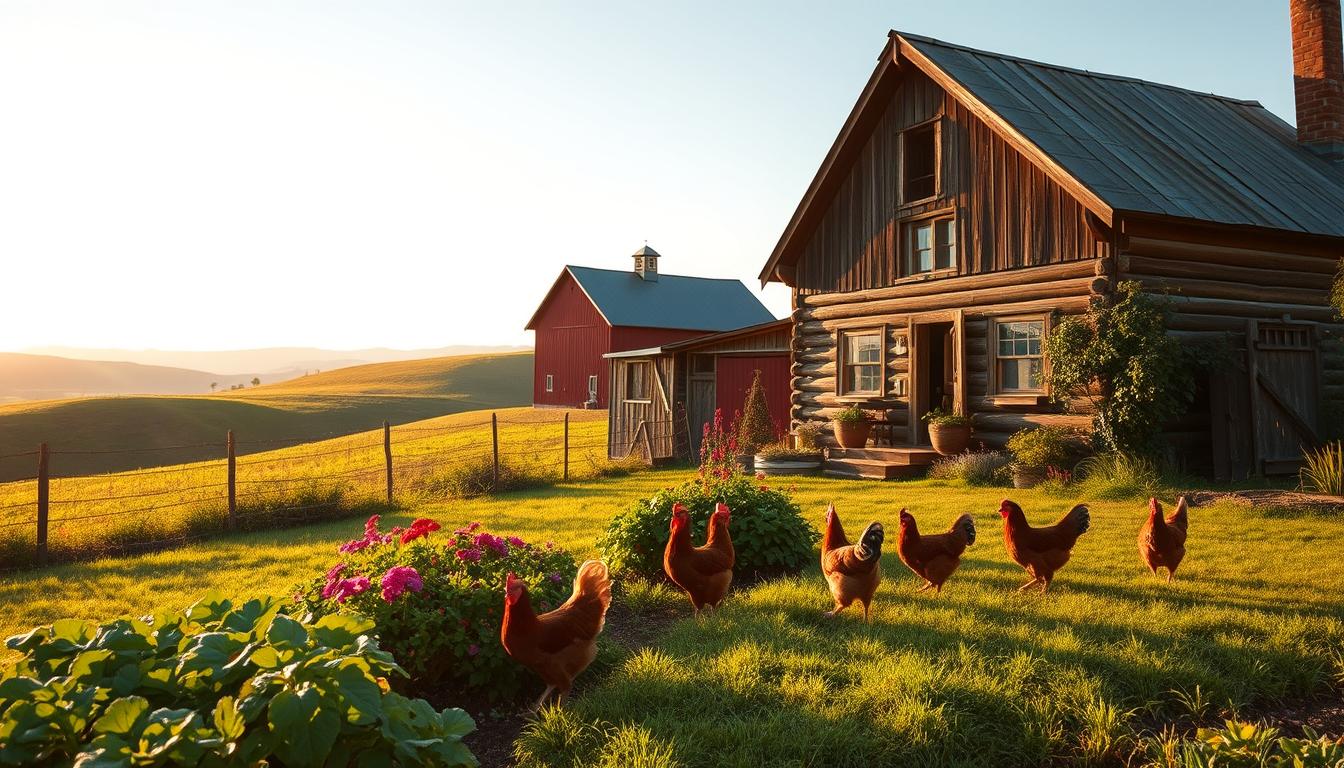In recent years, more people are embracing a lifestyle focused on self-reliance and sustainability. Since 2020, there has been a 40% surge in urban gardening interest, showing a growing desire to reconnect with nature and reduce dependence on external systems. Whether you live in a small apartment or own a large property, this way of life is adaptable to any space.
Modern homesteading is about creating a sustainable environment that works for you. It’s not just about growing food but also about building a natural, intentional lifestyle. From reducing grocery bills to fostering food sovereignty, the benefits are endless. My journey began 15 years ago, transitioning from condo renters to full-time homestead business owners, and it’s been a rewarding experience.
Remember, your path is unique. Start where you are, with what you have. This lifestyle is flexible and can be tailored to fit your family’s needs and goals. Let’s explore how you can begin your journey toward a more self-sufficient life.
Key Takeaways
- Urban gardening interest has surged by 40% since 2020.
- Homesteading can be adapted to any property size.
- Focus on food sovereignty and reducing grocery dependence.
- Flexibility is key—start with what you have.
- This lifestyle promotes natural living and sustainability.
What is Homesteading?
Homesteading has evolved from a historical necessity to a modern lifestyle choice. Legally, it’s defined as a home and surrounding land owned by a family, used for crops or livestock. Today, it’s about self-sufficiency through food production, preservation, and skill-building.
Historically, the Homestead Act of 1862 encouraged settlers to develop land in exchange for ownership. Modern homesteading, however, focuses on off-grid or semi-self-sufficient models. It’s no longer just about rural living—urban and suburban spaces are now part of the movement.
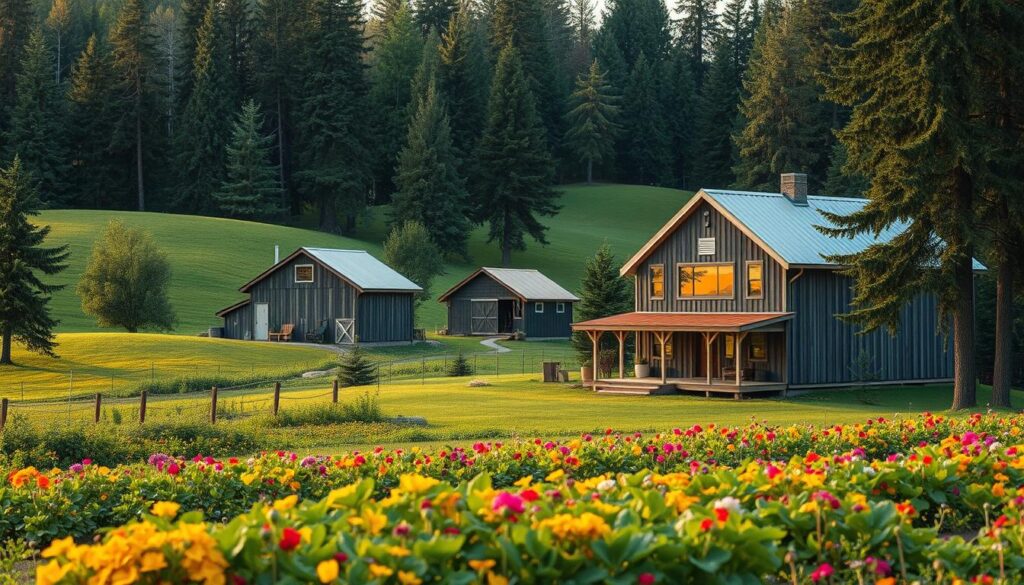
- Urban: Balcony gardens and vertical farming.
- Suburban: Backyard chickens and small-scale gardening.
- Rural: Larger properties with 5-10 acres for crops and livestock.
- Commercial: Farms spanning 20+ acres for business purposes.
Contrary to popular belief, homesteading doesn’t require vast acreage. In fact, 63% of new homesteaders start in suburban homes. Leah Payne, for example, transitioned from city life to running a sheep farm in Oklahoma through strategic land-sharing.
For those with limited space, micro-homesteading is a growing trend. It involves vertical gardens and nano-livestock like quail, proving that anyone can embrace this lifestyle, regardless of their living situation.
Why Start a Homestead?
Starting a self-reliant journey can bring environmental, financial, and health benefits to your family. This lifestyle isn’t just about growing your own food—it’s about creating a sustainable and fulfilling life. Let’s explore the key reasons to embrace this path.

Environmental Benefits
One of the biggest advantages of this lifestyle is its positive impact on the planet. By growing your own food, you reduce food miles to zero, compared to the average 1,500 miles for supermarket produce. Composting can divert up to 300 pounds of household waste from landfills each year.
Regenerative practices like composting and organic gardening also help restore soil health. These methods reduce your carbon footprint and contribute to a healthier ecosystem. It’s a small step that makes a big difference for the environment.
Financial Independence
This lifestyle can also save your family money. On average, families who grow 40% of their produce save $5,600 annually. While initial costs, like a $1,200 chicken coop, may seem high, the long-term savings are significant. For example, raising chickens can save $650 a year on eggs.
Additional income streams are another perk. Selling honey at farmers’ markets can fetch $18 per pound, compared to $6 for store-bought honey. These opportunities make it easier to achieve financial independence while living sustainably.
Health and Wellness
Your health can improve dramatically with this lifestyle. Studies show that 92% of homesteaders report better mental health. Growing your own food reduces pesticide exposure by 78%, according to EPA statistics.
Nutritionally, homegrown food is superior. For example, heritage pork contains 300% more omega-3s than factory-farmed pork. This lifestyle encourages a healthier diet and a more active, fulfilling life for your family.
Planning Your Homestead
Creating a self-sufficient lifestyle starts with thoughtful planning and preparation. The right setup ensures long-term success and minimizes unexpected challenges. Whether you’re working with a small backyard or a large plot, careful planning is essential.

Choosing the Right Location
Your property location plays a crucial role in your success. Start by analyzing sunlight patterns using tools like SunCalc.net. This helps you determine the best spots for gardening or solar panels.
Water access is another key factor. Consider the costs of drilling a well ($15-$30 per foot) versus setting up a rainwater catchment system. Reliable water sources are vital for both crops and livestock.
Understanding Zoning Laws
Before making any decisions, research local laws in your town or state. For example, minimum acreage requirements vary—0.5 acres for chickens and up to 5 acres for cattle. Building restrictions near navigable waterways, like creeks, may also apply.
If you plan to sell products, check for home business permits. Farm stands exceeding $15k in annual revenue often require special licenses. Staying compliant avoids legal issues down the road.
Assessing Your Property
Start with a soil test kit, which costs around $25. These kits reveal pH levels and nutrient deficiencies, helping you prepare the land for planting. Healthy soil is the foundation of a thriving garden.
Evaluate the slope of your property. A 2-5% grade is ideal for drainage without causing erosion. Proper assessment ensures your setup is both functional and sustainable.
By taking these steps, you’ll create a solid foundation for your self-sufficient journey. Planning ahead saves time, money, and effort in the long run.
Essential Skills for Homesteading
Mastering essential skills is the backbone of a successful self-sufficient lifestyle. Whether you’re growing your own food, raising animals, or preserving your harvest, these skills ensure you can thrive independently. Let’s dive into the key areas you need to focus on.
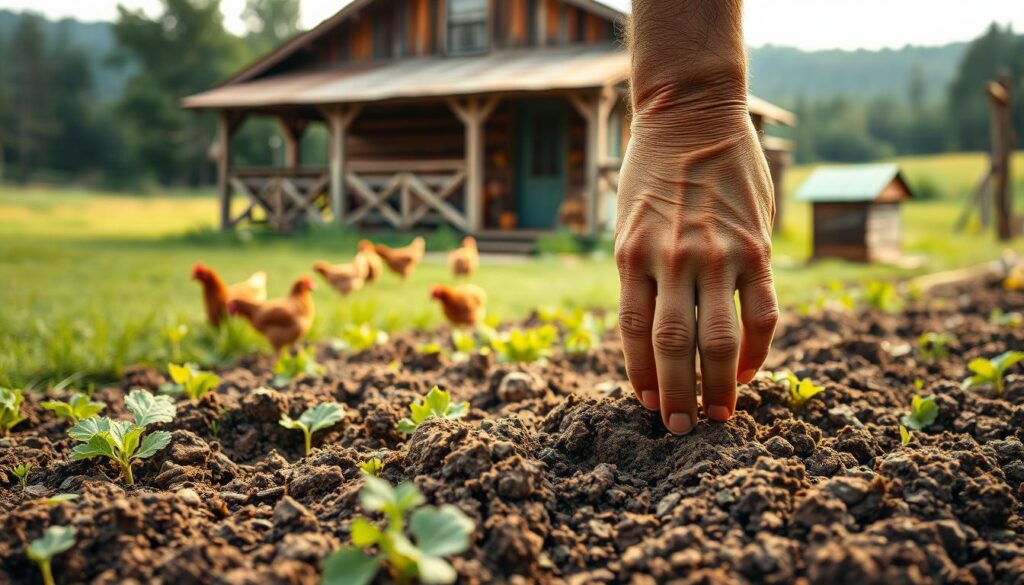
Gardening Basics
Starting a garden is one of the most rewarding steps toward self-sufficiency. Companion planting, like pairing tomatoes with basil, can increase yields by 20%. Plan your seed starting calendar carefully—nightshades, for example, should be started 6-8 weeks before the last frost.
Healthy soil is the foundation of a thriving garden. Test your soil’s pH and nutrient levels to ensure it’s ready for planting. With the right preparation, you’ll enjoy fresh produce all season long.
Raising Livestock
Raising animals like chickens can provide a steady supply of eggs and meat. Ensure your coop provides at least 4 square feet per bird, with 10 square feet in the run to prevent pecking disorders. Rotational grazing is another essential practice—move sheep every three days to avoid parasite buildup.
Emergencies can arise, so be prepared. For example, a prolapsed vent in chickens has a 23% mortality rate without immediate intervention. Staying informed and proactive ensures your animals stay healthy.
Preserving Food
Preserving your harvest ensures you have food year-round. Pressure canning retains 97% of nutrients, compared to a 40% loss after six months of freezing. For root vegetables, a root cellar with temperatures between 32-40°F and 85-95% humidity is ideal.
Lacto-fermentation is another effective method. A 2% brine solution prevents harmful bacteria, keeping your preserved food safe and flavorful.
| Method | Nutrient Retention | Best For |
|---|---|---|
| Pressure Canning | 97% | Vegetables, Meats |
| Freezing | 60% (after 6 months) | Fruits, Herbs |
By mastering these skills, you’ll build a sustainable, self-reliant lifestyle that works for you. Start small, stay consistent, and enjoy the journey.
Starting Your Homestead on a Budget
Embarking on a self-sufficient journey doesn’t have to break the bank—there are smart ways to start small and grow over time. With careful planning and creativity, you can minimize costs while building a sustainable lifestyle. Let’s explore how to make the most of your budget and resources.
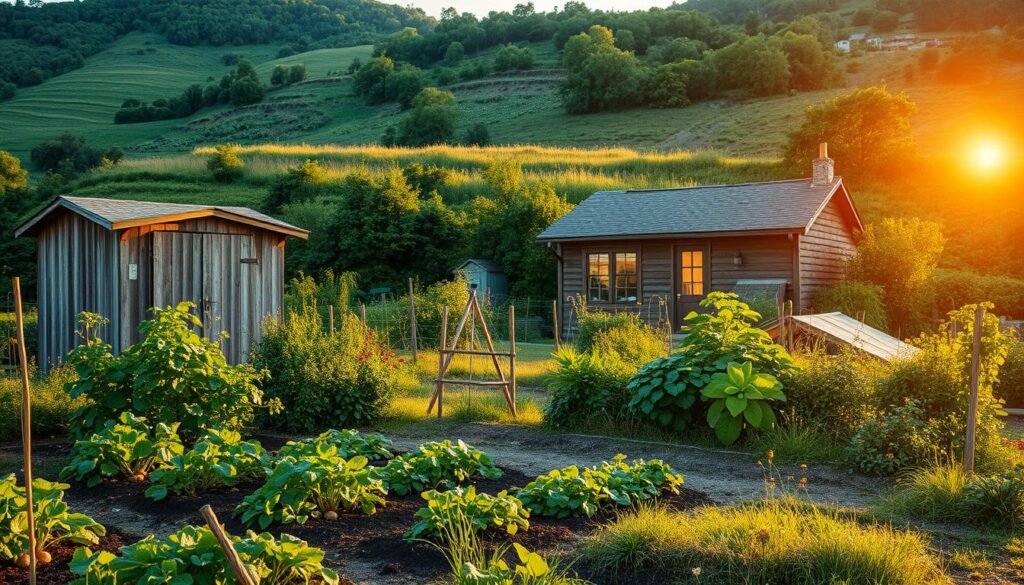
Budgeting for Self-Sufficiency
Creating a phased approach can help you manage money effectively. In the first year, focus on essentials like seeds and tools, which may cost around $1,000. Over five years, you can invest up to $18,000 in infrastructure, such as fencing or irrigation systems.
One effective strategy is the profit-center model. For example, selling excess seedlings at $4 per plant can fund your garden expansion. This approach turns your efforts into a self-sustaining cycle, reducing the need for external funding.
DIY Projects
DIY projects are a great way to save money while building your setup. A rain barrel made from food-grade IBC totes costs just $35, compared to $120 for commercial models. Similarly, a cob oven made from clay, sand, and straw can bake at 700°F for only $85.
These projects not only reduce costs but also allow you to customize your setup to fit your needs. Plus, they’re a fun way to learn new skills and make your space uniquely yours.
Second-Hand and Repurposed Materials
Repurposing materials is another excellent way to stay within budget. Barn wood sourced from demolition sites can save you up to 80% compared to buying new lumber. Used livestock panels, for instance, can be transformed into $22 trellises for your garden.
By thinking creatively and sourcing second-hand items, you can significantly reduce costs while building a functional and sustainable setup. It’s a win-win for your wallet and the environment.
Raising Animals on Your Homestead
Adding animals to your property can provide fresh food and reduce costs. Whether you’re raising chickens for eggs or goats for milk, these animals can enhance your self-sufficient lifestyle. They also offer companionship and help manage your land more effectively.
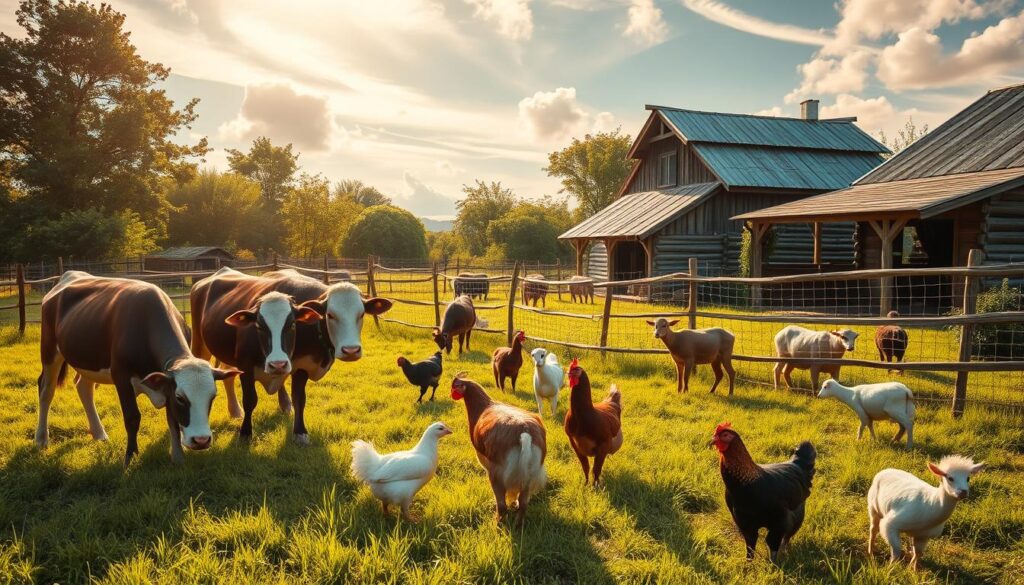
Choosing the Right Animals
Selecting the right animals depends on your space and goals. In urban areas, quail are a great option, requiring only 0.5 square feet per bird. Nigerian Dwarf goats are ideal for small-scale dairy, yielding up to half a gallon of milk daily. For meat, heritage breeds like rabbits offer a high return on investment, with a 10-week maturity period.
Building Shelters
Proper shelters are essential for your animals’ safety and comfort. Mobile chicken tractors, measuring 4’x8′, protect against 94% of predators. In colder climates, infrared heaters can prevent frostbite when temperatures drop below 20°F. A well-designed shelter ensures your chickens and other animals thrive year-round.
Feeding and Care
Feeding your animals properly is key to their health. Layer pellets are a staple for chickens, with each hen consuming about 1/4 pound daily. Medicinal herbs, like garlic water, can treat 60% of common poultry ailments. Regular care and attention will keep your animals healthy and productive.
By raising animals, you can enjoy fresh eggs, meat, and dairy while reducing your grocery costs. Start small, choose the right animals for your space, and watch your self-sufficient lifestyle flourish.
Growing Your Own Food
Growing your own food is a rewarding way to take control of your diet and reduce reliance on store-bought produce. With the right planning and techniques, you can create a thriving garden that provides fresh, organic food for your family year-round. Whether you have a large backyard or a small balcony, there’s a way to make it work for your space.

Planning Your Garden
Start by mapping out your garden space. Consider crop rotation to maintain soil health—rotate nightshades, legumes, brassicas, and alliums each year. Succession planting, like sowing lettuce every seven days, ensures a continuous harvest throughout the growing season.
Biointensive gardening can maximize yields. For example, a quarter-acre garden can feed a family of four. Plan your garden layout to make the most of your available space and resources.
Soil Preparation
Healthy soil is the foundation of a productive garden. Test your soil’s pH and nutrient levels to determine what amendments are needed. Worm tea, made from a 5:1 water-to-castings ratio and aerated for 48 hours, is an excellent natural fertilizer.
Consider using Hugelkultur beds, which use buried wood cores to retain moisture. This method can reduce watering needs by 25%. Adding mineral amendments like Azomite can also enrich your soil with 67 trace minerals.
Seasonal Planting
Timing is key to a successful garden. Use a frost date calculator with 90% confidence intervals from NOAA to plan your planting schedule. Overwintering techniques, like covering spinach with row covers, can protect crops in temperatures as low as -10°F.
By understanding your local climate and planting seasonally, you can extend your growing season and enjoy fresh produce for more of the year.
Homesteading as a Business
Turning your self-sufficient lifestyle into a profitable venture is easier than you think. Whether you’re selling fresh produce, handmade goods, or farm-raised animals, there are plenty of opportunities to make money while staying true to your values. Let’s explore how to turn your farm into a thriving business.
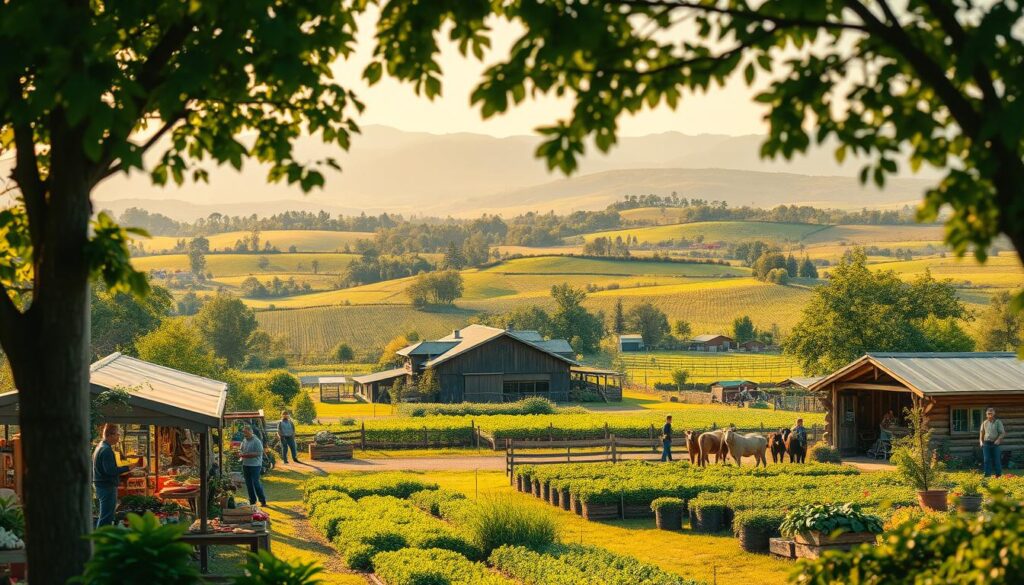
Creating a Business Plan
Every successful business starts with a solid plan. Identify your niche—specialty products like heirloom garlic can sell for $16 per pound, compared to $3 for conventional varieties. Consider a CSA (Community Supported Agriculture) model, where 20-week shares at $35 per week can generate $9,000 in seasonal revenue.
Choosing the right business structure is also crucial. An LLC can offer up to 35% in tax savings compared to a sole proprietorship. This step ensures your farm is set up for long-term success.
Marketing Your Products
Effective marketing can make or break your business. Farmers’ markets are a great starting point, but booth fees of $120 per day require selling 40 units at a $5 profit margin to break even. Social media platforms like Instagram can amplify your reach—reels showing lambing season, for example, get three times more engagement.
Label compliance is another key factor. The FDA requires packaged goods to display net weight and your address. Meeting these standards ensures your products are market-ready and professional.
Legal Considerations
Understanding local laws is essential for running a successful farm business. Cottage food laws in 38 states allow home-based sales of up to $20,000 annually without a commercial kitchen. Liability insurance, costing around $500 per year, can cover up to $1 million in product claims, protecting your business from unforeseen risks.
By addressing these legal aspects, you can focus on growing your business without unnecessary stress.
Ready to take the next step? Learn more about starting your garden to support your farm business. With the right planning and execution, your self-sufficient lifestyle can become a profitable and fulfilling venture.
Conclusion
Your journey toward a self-sufficient life begins with small, intentional steps. Remember, 87% of successful homesteaders started with just herbs and chickens. It’s not about having it all at once—it’s about building your lifestyle piece by piece.
Avoid comparing your progress to others. Your neighbor’s 40-acre setup likely took 15 years to develop. Focus on your pace and celebrate each milestone. Master essential skills, like three food preservation methods, before expanding further.
By Year 3, the average homestead reaches 55% self-sufficiency. That’s a significant achievement worth striving for. Start today—plant one heirloom tomato in a 5-gallon bucket and take that first step toward success.
Your journey is unique, and every effort counts. Begin now, and watch your homestead grow into a thriving, sustainable haven.

